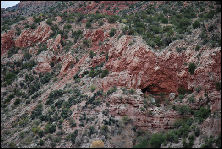The Lost Turner Mine
The landscape seems to always be in motion in the Sycamore Canyon Wilderness. Shadows drift around outcroppings, peaks and spires like ghosts playing hide-and-seek. Red, orange and cream-colored sandstone walls marbled with pinion, juniper and cypress trees bear deep gashes with stratified buttes topped with unfinished statues sliding imperceptibly toward the canyon’s belly. Indelibly mixed with the colorful canyon walls are legends of Spanish gold.
Stories tell of a long abandoned gold mine discovered by Spanish soldiers, in which the Yavapai and Apache methodically killed off the miners until just two were left to escape and tell its rich tale.
In fact, before the stream that carved the canyon was known as Sycamore Creek, it was known as Dragoon Creek, in recognition of the Spanish soldiers who allegedly worked the mine.
In 1889, some cowboys came across the skeleton of a man at Sycamore Canyon and found evidence of a fierce gun battle. This skeleton belonged to John Turner who was grubstaked by Michael Cooney to prospect in the Mogollon Mountains in 1883. A year later, not hearing from him, Turner's uncle showed up in Mogollon telling Cooney that he had come from the East to help mine a gold deposit John had found along Sycamore Creek, but that John had never showed up to meet him. Cooney searched Sycamore Canyon and found many blazed trees, but no sign of Turner or his mine.
Cooney spent the rest of his life in search of Turner's mine before he was caught in a winter storm in 1914 and froze to death within 100 yards of where Turner's skeleton was found in 1889. The rich vein is believed to be located near Sycamore Creek above its junction with the Gila River.. Ancient Spanish mines and relics can be found in the area of Ladrone Peak, 22 miles SW Belen. SITE: Old Mesilla, located near today's Mesilla, dates back to the days of Maxamilian, but settled in the 1850's. Many ruins surround the area, today a state monument. Antonio Salazar lived at Santo Nino and went into the W Portrillo Mountains to cut timber and while there uncovered an old Spanish mine tunnel. Entering the shaft, he chipped off samples of rich gold chunks and took the sack of gold home to show his wife. Elated at his new-found riches, he returned to the old mine site with tools and was never heard from again. Searches for the man ended in failure and it is believed that he was killed in a cave-in at the site.
The late Ron Plapp, who worked with the NFS as a fire official and became a local authority on the trails and history of Sycamore Canyon, hinted that a legend of a lost treasure could have some credence. Tales hold that a Spanish gold mine lies buried in a spot called Geronimo’s Cave along Sycamore Creek. “When I was working for the Forest Service,” explained Plapp during a phone conversation in the mid-1990s, “two men took up six mineral claims and opened a mine just above the fabled Spanish mine. To my knowledge, they never found any gold. “But,” he added, “one of the workers is said to have found Spanish armor.”
Treasure hunters have searched the canyon for years, to no avail. It should be noted, there is a minimal likelihood of gold existing in the canyon, as the geologic makeup of the canyon does not lend itself to precious metals. What the canyon lacks in precious metals, it more than makes up for in scenic beauty.

